Has the Apple smartphone "iPhone 4S" solved the blamed antenna problem of the previous generation "iPhone 4"? In order to verify this question, Nikkei Electronics asked the former professor of the Takushoku University, who had worked on antennas in the mobile phone company, to conduct tests. In the analysis process, it was also found that the CDMA2000-based iPhone 4S added a receive diversity function.
This article refers to the address: http://
The antenna problem of the "iPhone 4" is that the signal receiving sensitivity is deteriorated when it comes into contact with the lower left side of the casing. We actually tested the receiving sensitivity in 2010, and there is indeed a phenomenon of deterioration.
In 2011, the follow-up model "iPhone 4S" was launched. Compared with the iPhone 4, how does the iPhone 4S improve reception sensitivity, which is a technical topic of great interest to the editorial department.
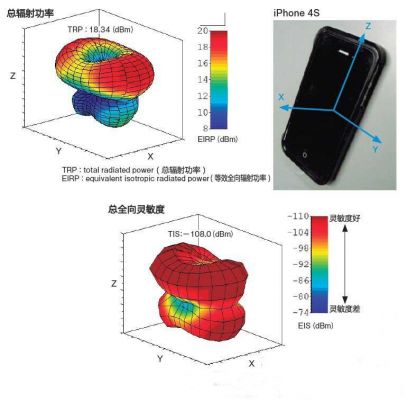
Good wireless performance
The values ​​of TRP (total radiant power) and TIS (total omnidirectional sensitivity) indicating the wireless characteristics of the mobile phone have obtained good results. The three-dimensional receiving sensitivity was detected while rotating the mobile phone. The more reddish the part, the better the receiving sensitivity.
Therefore, the signal reception sensitivity of the iPhone 4S was tested this time. In conclusion, the iPhone 4S has excellent wireless features, and the signal reception sensitivity is poorly improved when handheld (Figure 1). In addition, the CDMA2000-based iPhone 4S introduces a new technology that can reduce the deterioration of reception sensitivity when handheld.

Figure 1: Receiver sensitivity is greatly improved
The iPhone 4S has excellent wireless features, and the degree of reception sensitivity reduction during handheld control is controlled at 7 to 18 dB.
Let's talk about the receiving sensitivity detection results of the iPhone 4S and the items that are clear through the analysis components, and look forward to the next-generation models.
Virtual base station
The detection of signal reception sensitivity was carried out in the anechoic chamber of the Cooperative Research Center of the University of Japan's Takushoku University (Fig. 2). In the anechoic chamber, a virtual base station was set up using the base station simulator "MT8820A" manufactured by Anritsu, and communication was performed with the iPhone 4S equipped with a SIM card for detection.
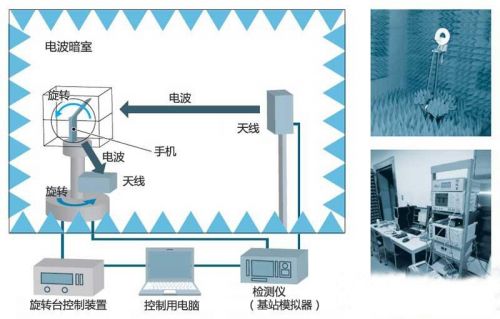
Figure 2: Detection environment
The reception sensitivity test was carried out in the anechoic chamber of the Japan-based Cooperation Research Center of Takushoku University. The receiving sensitivity of the iPhone 4S was detected after setting up the virtual base station.
In the detection of the iPhone 4S in the W-CDMA mode, a SIM card-compatible model purchased in Canada and an iPhone 4 note 1 for comparison with Japan Softbank Mobile were prepared. The CDMA2000 method uses au's iPhone 4S. In order to compare with the iPhone 4, the frequency uses the 2 GHz band.
Note 1) The iPhone 4S of Softbank Mobile does not support the SIM card for detection, so the iPhone 4S compatible with the SIM card is used.
The detection method using the virtual base station is a standard method used by the mobile phone manufacturer to detect wireless characteristics including signal reception sensitivity. The method of comparing the communication speed of the iPhone 4S in the street can be said to be not suitable for evaluating the performance of the mobile phone. This is because the difference in the number of mobile phones of each base station and the influence of the surrounding radio wave conditions may cause the communication speed to change. In addition, the line speed of the base station and the switch, and the response speed of the server used in the detection also affect the communication speed (2).
Note 2) In addition, in the comparison of the ping response speed, the difference between the protocol and the communication method before connecting the line has a great influence.
Good wireless performance
There are three detection items in the W-CDMA system: 1 the sum of the power radiated by the mobile phone to the space, that is, the "total radiated power (TRP)", and the average value of the receiving sensitivity of the mobile phone from various angles, that is, "total" The sensitivity to the sensitivity (TIS) and 3 is similar to that of a human hand (a test instrument named Phantom). All of the above three items are tested according to one of the standard test methods developed by the third generation mobile phone standardization bodies "3GPP" and "3GPP2", namely the Test Plan For Mobile Stations Over-The-Air Performance.
The TRP in 1 and the TIS in 2 indicate the strength of the mobile phone in terms of wireless communication performance, and are indicators that reflect the design of the antenna and the RF circuit. In operation, while rotating the mobile phone set at the position away from the virtual base station, the TRP and TIS are calculated based on the detection result.
The test results show that the W-CDMA iPhone 4S has the same TRP and TIS values ​​as the iPhone 4 (see the opening figure in this article). The value of TRP is close to the upper limit of the transmission power in the 2 GHz band defined by the Japanese Radio Wave Act. TIS has reached the standards of the most stringent Japanese mobile phone service operators in the world. 3GPP and 3GPP2 give the recommended values ​​for TRP and TIS, and Apple estimates that these values ​​are followed.
Compared with the iPhone 4, the components and layout of the iPhone 4S have also been changed. It is estimated that Apple has mastered the technology of reducing noise by enhancing shielding and adding capacitors to improve wireless characteristics to a certain level.
Reduces the reduction in receiving sensitivity
In order to confirm the change in the receiving sensitivity at the time of handwriting, the test was carried out using the analog hand (Phantom) in 3. The Phantom used this time is a special product manufactured by Microwave Factory of Japan. The product uses materials that mimic the dielectric constant of the human body while making the surface conductive.
Phantom was placed so that it touched the black gap on the left side of the fuselage on the iPhone 4, and the receiving sensitivity was detected. Since the vertical rotation cannot be achieved while the Phantom is holding the mobile phone, only the horizontal data is measured (Fig. 3).
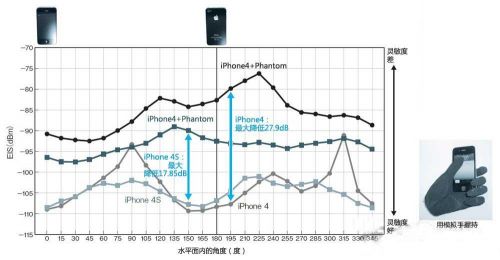
Figure 3: Change in receiving sensitivity when handheld
The change in receiving sensitivity when holding the mobile phone with the Phantom of the simulated human hand was detected. From the perspective of the decline in receiving sensitivity when handheld, the iPhone 4 has a maximum of 27.9 dB and the iPhone 4S has a maximum of 17.85 dB.
The test result is that even with the iPhone 4S, the receiving sensitivity is reduced when using Phantom. However, its decline is much less than that of the iPhone 4. The iPhone 4 dropped by 5 to 28 dB, while the iPhone 4S only dropped by 7 to 18 dB. A 6dB difference in reception sensitivity is equivalent to a half-time reduction in the distance of receiving radio waves from a base station. Therefore, the difference in receiving sensitivity between the iPhone 4 and the iPhone 4S can be said to be very large.
When the structure of the iPhone 4 is blocked by hand to block the black slit portion on the left side of the fuselage, the power supply point and the ground are short-circuited. The iPhone 4S partially changed the internal structure while strengthening the grounding, thereby solving the problem of reduced receiving sensitivity.
For example, the iPhone 4S adds a leaf spring to the speaker module next to the antenna (Figure 4). This is estimated to ensure contact with the ground portion, thereby reducing the potential difference. In addition, it is estimated that improvements in optimizing the antenna impedance to make it less susceptible to hand are also implemented.
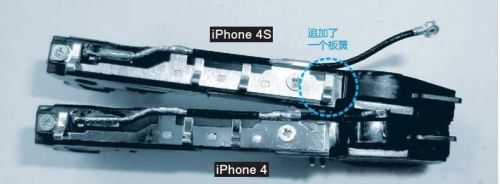
Figure 4: Enhanced grounding
The iPhone 4S implemented an improvement that was estimated to enhance grounding.
The improvement of the receiving sensitivity of the mobile phone not only brings benefits to the user, but also reduces the signal transmission power of the base station. As the output power decreases, the interference between adjacent base stations decreases, and the number of communicable mobile phones can be increased, so that the mobile phone service operator can improve the utilization efficiency of the base station. However, the amount of data will increase, and new problems such as congestion of backbone lines may be produced.
CDMA2000 mode additional receive diversity function
The above is the detection result implemented by the W-CDMA virtual base station for comparing the iPhone 4S and iPhone 4. In Japan, Apple has added CDMA2000 models from the iPhone 4S. So this time I also used au's iPhone 4S to evaluate the CDMA2000 method. As a result, it was found that the CDMA2000 method embeds a reception diversity function for improving reception sensitivity.
Through the dismantling of Nikkei Electronics, there are four gaps on the iPhone 4S, and a coaxial cable is added to the IC part of the power amplifier. It is conceivable that the four slits divide the frame into three parts: the upper part, the middle part and the lower part in a high frequency state. The "high-frequency state" is said here because the high-frequency circuit realizes the grounding sharing and realizes electrical connection with a certain point on all components.
If the lower part of the fuselage is regarded as the main antenna and the upper part of the fuselage is regarded as the sub-antenna, a new coaxial connection line can be added to the power amplifier IC section (Fig. 5). In other words, Apple is equipped with the "receive diversity" function supported by CDMA2000 on the iPhone 4S.
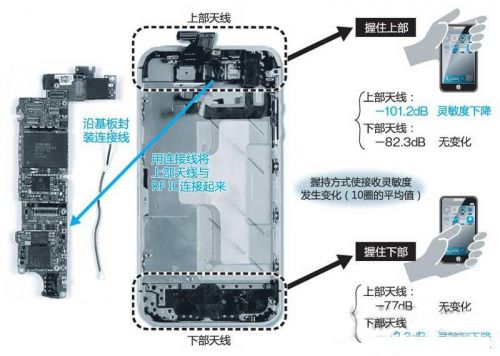
Figure 5: Equipped with receive diversity
The iPhone 4S has a cable that connects the upper antenna to the RF IC on the substrate. The CDMA2000 method is estimated to be equipped with a receive diversity function that uses upper and lower antennas depending on the situation.
Receive diversity is a receiving sensitivity improvement technique that has long been used in the field of wireless communications. The principle is that a plurality of receiving antennas are prepared in advance, an antenna having a good radio wave state is selected to receive signals, or a phase synthesizing process is uniformly performed on signals received by all antennas. The CDMA2000 baseband IC is mainly supplied by Qualcomm. The company began to integrate the receive diversity function of two antennas into the IC in 2004, enabling some mobile phone manufacturers to achieve this function.
There is a difference in the degree of decline in the receiving sensitivity of the upper and lower parts
If the CDMA2000-based iPhone 4S implements the reception diversity function, even if it is held in the lower part of the iPhone 4S while browsing the webpage, the upper sub-antenna that is not affected by the hand functions, and the reception sensitivity can be further prevented from being lowered.
To confirm this, we tried to open the evaluation mode screen for the iPhone 4S for developers. Two items "RX1" and "RX0" which are considered to indicate the receiving sensitivity of the upper and lower antennas appear on the screen. We used Phantom to confirm the change in value when holding the upper and lower parts.
When holding the upper part of the iPhone 4S with Phantom, only the value of RX1 indicating the receiving sensitivity of the upper antenna is deteriorated, and RX0 does not change. The opposite result is obtained when holding the lower part. Judging from this result, the 4S is equipped with an algorithm that selects an antenna with good reception sensitivity to receive signals, and realizes the reception diversity function.
From the perspective of the decrease in the receiving sensitivity, the lower antenna is about 10 dB, which is equivalent to the drop when the W-CDMA iPhone 4S is held by hand. The upper antenna was reduced by 24dB from the hand and dropped to -101.2dB. The difference in the degree of this decrease is caused by the difference in the construction of the upper antenna and the lower antenna.
What will the new generation of iPhone look like?
Let's review the results of this analysis to speculate on a new generation of iPhone that is expected to be unveiled in the near future. Not only the iPhone, but future smartphones are estimated to be cost-effective in a model-marketing country, that is, a global model. However, countries can use different frequencies, and even if they take the greatest common divisor, they need to support multiple frequencies. For example, the iPhone 4S is equipped with two power amplifier ICs for supporting the 3G band and is equipped with a power amplifier IC for GSM Note 3).
Note 3) The editorial department carried out analysis based on the power amplifier IC of the iPhone 4S with the assistance of D-CLUE Technologies of Japan. Between the Qualcomm RF transceiver IC and the antenna, four ICs are mainly connected. The reason for having multiple ICs is to support multiple frequency bands. It can be judged from the IC model that the following band types are supported: au, NTT DoCoMo, the 2 GHz band used by Softbank III, the 800 MHz band used by au and NTT DoCoMo, and the 900 MHz band called "Platinum Band". One of the reasons why mobile phone service operators strive to obtain the "Platinum Band" is that they can be used on the iPhone 4S.
In the future, LTE (Long Term Evolution), which is introduced first by NTT DoCoMo, must be equipped with MIMO (Multi Input Multi Output). In particular, "2 x 2 MIMO", which can transmit two kinds of data through two antennas, must be installed with two transceivers.
If the next-generation iPhone wants to support LTE, the installation problem of the two antennas has been solved with the receiving diversity of the iPhone 4S, but the package area of ​​the RF transceiver IC, including the power amplifier IC, will be about twice as large as the current one (Figure 6 ). In addition, since twice the number of power amplifier ICs are simultaneously driven, the power consumption will also double.

Figure 6: The number of components will increase when LTE is supported
To increase the next-generation communication function of the iPhone 4S, LTE 2×2 MIMO, the number of power amplifiers will increase, and the current substrate size cannot be accommodated.
The current countermeasure is to use power amplifier IC technology that supports multiple bands. However, in order to achieve the same continuous talk time as the iPhone 4S, you can only increase the size of the case by two turns and increase the battery capacity. If Steve Jobs is still alive, will it allow the next-generation iPhone to be two laps larger than the current model? Or is the new generation of iPhone showing us more innovation?
Far Infrared Heat Film is good for human's health care,it's mainly used in PET heater film for cold-proof face mask,direct selling health care mask polyimide (PI) film,masking film electrical heating Polyimide Film, electric heating sheet mask,health eye mask carbon fiber heating film,Infared Heating film,keep fit heating film, Heating Film For Eye,eye massage thin heated element etc.we are a professional and leader Chinese exporter of heat film,Customization options (for example: SMT components, flex cable and connectors) can provide the perfect complete solution that can significantly reduce assembly time and increase productivity.Providing a variety of complex shapes design, and different power designs. Membrane in the same piece electrically heated heating circuit can be designed and holding circuit,we are looking forward to your cooperation.
Health Care Heat Film For Mask
Health Care Heat Film For Mask,Body Heat Film,Infared Heating,Heating Film For Eye
ShenZhen XingHongChang Electric CO., LTD. , https://www.xhc-heater.com